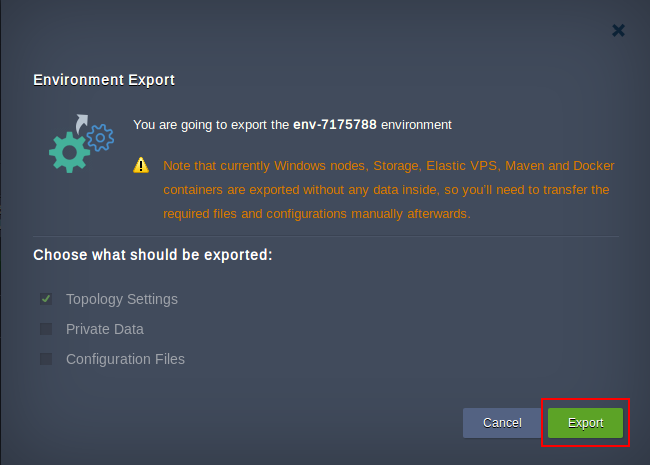CloudJiffy made provision that, You can easily move environments between Clouds in order to find out which one meets your requirements.
Two main stages include under the procedure
1. Export the already existing environment (You’ll consider this operation in details below)
2. Subsequent of that environment to import to the target CloudJiffy installation.
The operations will take just a few minutes. In a result, you will get an identical ready-to-work copy of the environment being run at another CloudJiffy installation.
How do I create copy of my environment
During the export, all information about the environment (i.e. its topology settings, deployed applications, links to the archives with configurations and private data it contains, etc) is packed into a single .json file. This compact JSON package can be simply downloaded to your local computer for being stored and/or deployed at another CloudJiffy platform.
So in order to export a copy of environment, log into CloudJiffy account and follow the instruction below:
1. Select Settings button for the environment that would like to export (named Cloudjiffy in our case).
Note that environment should have the Running status for being exported.
2. In the opened Settings tab, navigate to the Export section and click on the same-named button.
3. Within the appeared Environment Export dialogue, choose which data should be exported (tick all options to get the fully identical environment copy):
- Topology Settings - environment configurations have set through the Environment topology wizard (this point is obligatory and enabled by default)
- Private Data - files in directories of the deployed application(s) and private data stored within the database server(s)
- Configuration Files - all files, accessible via Configuration Manager at on dashboard, and settings of the deployed GIT/SVN projects (e.g. repositories links, access credentials, attached private SSH keys, etc)
Note: For ensuring the application and data safety, it is highly recommended not to delete original of the exported environment until its copy is successfully imported to another platform.

Once the required for export data is defined, click the Export button to proceed.
Depending on the type of containers the environment contains, should take into account the following points:
- Docker and Windows-based containers cannot be exported currently
- Data from Elastic VPS and Maven nodes won’t be exported, though they will be still included to the topology of imported environment, so you can be able to reconfigure these servers manually afterwards
- Private SSH key, exported alongside with the rest of GIT repository settings, can’t be deleted from the imported environment and is not shown at the dashboard, though it will still be used for a connection. Nevertheless, it will be substituted if choosing a new one within the GIT project’s settings window
4. Once the export is successfully finished, a new clickable string (named due to the export time/date) will appear in the Exported Environment Copies list.
Select it to download the compiled .json file with exported environment data to the local machine, or just right click on it to copy direct URL to this manifest (which can be also used during import).
In addition, you will receive the appropriate email notification with a link to the list of the exported environments.
You can create as many exported environments’ archives as you need, but note that all of them will be stored in your disc space, which is charged according to the hosting service provider's tariffs.
If a particular file is no longer needed, then you can delete it by means of clicking the red cross button right before the corresponding string.
That’s all!
You have successfully exported your environment copy.
Now, you can proceed to its importing to the target platform in order to complete the migration.